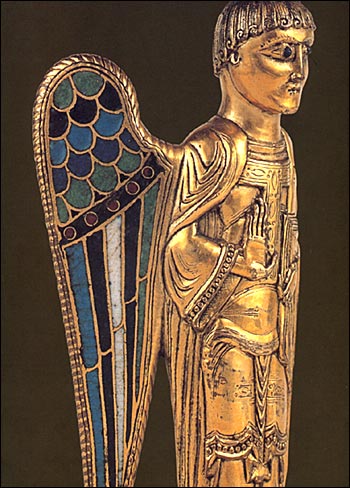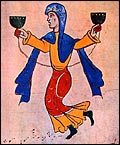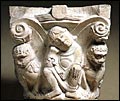
Statuette, Ange Limoges, c. 1120–1140 Copper gilt, champlevé and cloisonné opaque enamel. H. 23.6 cm; W. 9.8 cm.
From the treasury of the Abbey of Grand-mont. Church of Saint-Sulpice-les-Feuilles
(Haute-Vienne) © Philippe Rivière. -1997 Inventaire Général, ADAGP
|
|
MUSÉE DU LOUVRE
75058 Paris Cedex 01 Napoléon Hall
Métro Palais Royal Musée du Louvre
INFORMATION:
Tel. (33) 01 40 20 53 17
Site : www.louvre.fr
e mail : info@louvre.fr
HOURS:
Open daily except Tuesdays from 9 a.m. to 5.30 p.m., and until 9.30 p.m. on Wednesdays and Fridays.
ADMISSION FEES:
Admission to the exhibition only: 8.50 euros.
Admission to permanent collections + the exhibition Romanesque France: 13 euros before 6 p.m., 11 euros after 6 p.m.
Free admission for youths under 18, unemployed, and holders of the “Louvre Jeunes”, “Louvre Professionnels”, “Louvre Enseignants”, “Louvre Etudiants Partenaires” or “Amis du Louvre” cards
CURATOR:
Danielle Gaborit-Chopin, Curator in Charge,
Objets d’Art Department, Musée du Louvre
PRESS CONTACTS:
Déléguée à la Communication : Aggy Lerolle
Chargée de communication : Sylphide de Sonis sylphide.de-sonis@louvre.fr
Chargée de communication Auditorium : Marie Bernot marie.bernot@louvre.fr
AUDITORIUM DU LOUVRE :
Access through the Pyramid and the Carrousel galleries.
And from 9 am to 6 pm through passage Richelieu.
Informations: 01 40 20 55 55 - Réservations (everyday from 11am to 5 pm, except tuesdays) Tel. 01 40 20 55 00

|
Modern day France began to take shape during the Romanesque period. The French countryside is rich in Roman and Romanesque monuments which are amongst its most visited sites. Even so, there has been no major comprehensive exhibition of Romanesque art in France. The Louvre was able to assemble 300 works - sculptures, everyday as well as precious objects, manuscripts - that are representative both of the various modes of artistic expression and of the diversity of French regions This exhibition brings together many world-renowned masterpieces, some of which have not been displayed to the public for fifty years. It also provides an opportunity to bring together a number of works now dispersed throughout the world, such as the two fragments of a wooden statue of Christ, made in the centre of France, one piece of which is held in the Louvre and the other in the collections of the Cloisters in New York
A white mantle of churches
�The development of Romanesque art coincides with a number of significant political, social, economic and religious transformations. France came to be covered, in the words of the Benedictine chronicler Raoul Glaber, by a white mantle of churches.The founding of the order of Cluny and then of Cîteaux spurred the rise of the great monasteries, many of which became dynamic centres of artistic creation. The Church developed the cult of the saints. Illuminated collections related their lives and miracles, while the sites housing their relics became places of pilgrimage. This phenomenon encouraged the circulation of people, ideas and art objects. Contacts with the Byzantine and Muslim world provided new sources of inspiration: A wondrous menagerie was deployed at that time, as objects from backgammon pieces to sculptures are overrun by monstrous and fantastical beasts. Music plays a new role, its significance communicated in painted and sculpted.representations
Illustration: Tropaire-prosier of Auch (music manuscript) Illumination on parchment, Auch, mid-11th century, 24.5 cm x 15 cm Paris, BnF, Cabinet des manuscrits © BnF
Major artistic centres
Although it may not be possible to speak of regional schools, the exhibition provides the opportunity to bring together the most remarkable remaining roman works. All of France is there : the reliefs of the Cathedral of Saint-Lazare d’Autun, the celebrated and whimsical illuminated manuscripts of the Abbey of Cîteaux, capitals from the Abbey of Saint-Benoît-sur-Loire, stained-glass windows from the Abbey of La Trinité in Vendôme, capitals from the Abbey of Saint-Michel-de-Cuxa and from the Cathedral of Saint-Etienne in Toulouse, the treasuries of Conques, the astonishing bibles from the Limousin region, the striking Apocalypse of Saint-Sever, precious ivory and silver from Normandy and the North... The renowned porphyry and gilded silver vase known as Suger’s Eagle attests to the authority of this abbot of Saint-Denis, architect of the consolidation of power by the kings of France.
The extraordinary efflorescence of the 12th century:
Three main themes illustrate the extraordinary efflorescence of the 12th century: The storied capitals treat an awe-inspiring range of subjects, including among others the racy theme of the Dispute from Poitiers, or the contemplative Daniel in the Lion’s Den from Sainte-Geneviève in Paris. The birth of champlevé enamelling is illustrated by the exceedingly rare medallions unearthed in archaeological digs, the first objects in iridescent colours, and above all by the statuette of the angel from Saint-Sulpice-les-Feuilles. The exceptional grouping of wooden and silver reliquary statues from the centre of France, .bedecked with precious metals and stones, the Saint Baudime from Saint-Nectaire, the Saint Chaffre from Le Monastier and the Enthroned Virgin and Child from the Louvre allow us to ascertain the decisive impact of this anthropomorphic reliquary in the development of new forms.
Illustration: Capital Daniel in the Lion’s Den Marble. Aquitaine, 6th century, then Ile-de-France, 1st quarter of the 12th century H. 49.5 cm; W. 53 cm; D. 51 cm. Paris, Musée du Louvre, Dept. of Sculptures, RF 457 © RMN
Exhibition organized by the Louvre, with the Réunion des Musées Nationaux, and the exceptional participation of the Bibliothèque Nationale de France.
Crédit Agricole is the exclusive sponsor of this exhibition.
PUBLICATIONS
Exhibition catalogue Romanesque France, edited by Danielle Gaborit-Chopin, 400 pages, ill. coul. Coéd. Musée du Louvre / Hazan 39 €.
Jean-René Gaborit et François Avril Album Romanesque France, the 60 major works shown in the exhibition. 8€.
Xavier Dectot Romanesque art in France, L’Atelier du monde” series. This companion volume is devoted specifically to Romanesque architecture. 144 pages, 18 euros.
Danielle Gaborit-Chopin, Jean-René Gaborit and Jannic Durand, Romanesque art at the Louvre, “Trésors du Louvre” series, 52 € A Musée du Louvre Editions / Fayard co-edition Available from Fall 2005
Petit journal de l’exposition, éditions RMN, 3 €
RELATED EVENTS
Guided tours Special visits for the visually impaired. Teacher preparation sessions. Workshops
Events in the Auditorium du Louvre :
A conference presenting the exhibition; A “Musée-musées” symposium on Romanesque cloisters. Conferences. Readings. Art films More information: www.louvre.fr
|










